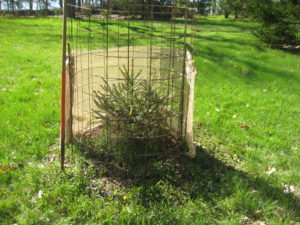Winterburn
This spring a lot of folks are still commenting about how last winter seemed especially difficult. And as the new growing season unfurls, it is becoming evident that the plants agree. Conspicuous evidence of their difficulties is winterburn among the evergreens.

Winterburn of a row of young arborvitae cultivars. Road salt is probably also an issue here.
Winterburn, in spite of the word implying heat, is caused by dehydration, rather similar to freezerburn of food left in the freezer. Evergreens do carry on a bit of photosynthesis during sunny winter days, which includes a slow rate of transpiration from the needles. But if the soil is frozen for an extended time, they cannot replace this water fast enough via their roots and desiccation of the needles begins to happen. In clear and cold weather, the warmest part of winter days is the early afternoon, producing the most transpiration, so winterburn usually appears first on the southwest-facing part of evergreens. This can be just a minor problem with the tips of needles turning brown, or it can become serious, producing dead needles, twigs, and branches.
The abruptness of weather change can also play a role. Our mild early winter left plants not fully prepared when deep cold arrived rather suddenly in late January – see Climate III: Visualizing Our Big Picture regarding how our Polar Vortex was aided in its development by an overheated North Pacific Ocean.
Seedlings and youngsters have small and poorly established root systems, and are particularly vulnerable to winterburn. Things you can do to help prevent this include:
- Shelter against the wind:

A demonstration of a burlap shelter attached to a buck cage.
The winter wind is a strong desiccator so sheltering little evergreens on their northwest sector can be very useful. I like to make burlap screens because landscaping burlap is cheap and easy to work with. Where I have already put up a stout cage to prevent bucks from racking the little tree, a half-circle of burlap can be simply attached to the cage on the northwest side. One year I had 2’ diameter by 2’ tall chicken wire cages around small arborvitae to protect them from bunnies. So I sprinkled a couple of naphthalene mothballs into each cage and stuffed in a large double handful of oat straw, which initially mostly covered the little trees. After a while the straw settled and become more of a fluffy mulch. Some people report that naphthalene mothballs do not deter mice very well, so maybe I was lucky that time.
- Prevent or slow soil freezing: In a mild winter in a sheltered location, four inches of course wood chip mulch covered by a foot of snow will prevent the soil from freezing, as long as the snow lasts. In less favorable circumstances the mulch alone will slow down the freezing process.
- Hydrate the soil before ground freeze: A soaking watering in late autumn before the ground freezes helps prevent dehydration of any size evergreen.
- Avoid fertilizing seedlings and young trees: The rapid growth can continue into early autumn when they should be shifting their chemistry toward winter dormancy and maintenance. Also do not plant evergreens in autumn because it leaves them little opportunity to develop a root system for adequate uptake of water. In some winters, even autumn-planted deciduous seedlings desiccate and die.
There are spray-on products available which are advertised to leave a waxy coating on needles and slow winter dehydration. I’ve never used these because needles and leaves already have stomata which the plants use to regulate water loss and I’m concerned that if these get clogged with wax the plant will develop other problems.
If you already have winterburned evergreens and they are only lightly scorched, just leave them alone and the dead needles will shade the new buds that will gradually replace the old needles. If more than half the plant is damaged it might not recover. Also, make sure they stay well-watered. So far, this spring doesn’t need your watering intervention.
Tags: Lon Drake, winterburn

